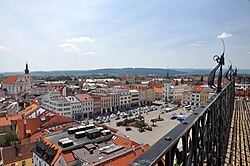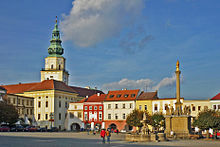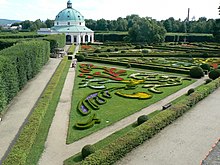Town in Zlín, Czech Republic
| Kroměříž | |
|---|---|
| Town | |
 Town square seen from the castle tower Town square seen from the castle tower | |
 Flag Flag Coat of arms Coat of arms | |
 | |
| Coordinates: 49°17′56″N 17°23′35″E / 49.29889°N 17.39306°E / 49.29889; 17.39306 | |
| Country | |
| Region | Zlín |
| District | Kroměříž |
| First mentioned | 1107 |
| Government | |
| • Mayor | Tomáš Opatrný |
| Area | |
| • Total | 50.98 km (19.68 sq mi) |
| Elevation | 201 m (659 ft) |
| Population | |
| • Total | 28,089 |
| • Density | 550/km (1,400/sq mi) |
| Time zone | UTC+1 (CET) |
| • Summer (DST) | UTC+2 (CEST) |
| Postal code | 767 01 |
| Website | www |
| UNESCO World Heritage Site | |
| UNESCO World Heritage Site | |
| Official name | Gardens and castle at Kroměříž |
| Criteria | ii, iv |
| Reference | 860 |
| Inscription | 1998 (22nd Session) |
Kroměříž ([ˈkromɲɛr̝iːʃ] ; German: Kremsier) is a town in the Zlín Region of the Czech Republic. It has about 28,000 inhabitants. It is known for Kroměříž Castle with its castle gardens, which are a UNESCO World Heritage Site. The historic town centre with the castle complex is well preserved and is protected by law as an urban monument reservation.
Administrative parts
The villages of Bílany, Drahlov, Hradisko, Kotojedy, Postoupky, Těšnovice, Trávník, Vážany and Zlámanka are administrative parts of Kroměříž.
Geography
Kroměříž is located about 20 kilometres (12 mi) northwest of Zlín. About two thirds of the municipal territory lies in the Litenčice Hills, the eastern part lies in the Upper Morava Valley. A small southern part extends into the Chřiby range. The highest point of the territory is the Obora hill at 322 m (1,056 ft) above sea level. The town is situated on both banks of the Morava River. The Haná River flows into the Morava on the northern outskirts of the town.
History


The first written mention of Kroměříž (under its Latin name Cromezir) is in a document written between 1107 and 1125, when the settlement was bought by Olomouc bishop Jan II. Some sources cite a deed of another Olomouc bishop Jindřich Zdík from 1141 as the first unquestionable written mention of Kroměříž. In the Middle Ages, it was a market village on the crossroads of the Amber and Salt roads. It was located at a ford across the Morava where the toll was collected.
In the 13th century, Kroměříž became the centre of a dominion owned by the Olomouc bishopric. The Knights Hospitaller settled here and built a church and a commandery in 1238. In 1241 and 1253, Kroměříž suffered raids by the Tatars, Cumans and Hungarians. The settlement got depopulated and had to be recolonized. Kroměříž is last referred to as a market village in a document by Ottokar II of Bohemia from 1256. After 1256, the Olomouc bishop Bruno von Schauenburg came to power over Kroměříž. He improved the town and fundamentally contributed to its development. He founded the market square on the hill above the original settlement and had it surrounded with walls. He also had the Church of Saint Maurice built and had vineyards planted around the settlement. In 1266, Kroměříž was first referred to as a town.
In 1322, Jews were allowed to settle in the town. In the mid-16th century, the Kroměříž Jewish community was the largest serf Jewish community in Moravia. The bishops protected the community for the income flowing from it.
During the rule of bishop Stanislav I Thurzo, the local bishop's residence was repaired and rebuilt into a late Gothic and Renaissance castle. His followers further refined the town and provided costly building repairs.
The town and the castle were badly damaged in the Thirty Years' War. It was plundered by Swedish troops under command of Lennart Torstensson in 1643. Most of the buildings were burned down. The town was further damaged by a large fire in 1656. Kroměříž recovered during the rule of Bishop Karl II von Liechtenstein-Kastelkorn, who had rebuilt the town and the castle. The castle was first repaired, and in 1686 completely rebuilt. He also has repaired town walls, and founded a mint and representative gardens in 1666–1675. Kroměříž again became an important town.
The Constitutive Imperial Congress sat in Kroměříž in 1848. In August 1885 a meeting took place here between the Austrian and the Russian emperors.
Demographics
|
|
| ||||||||||||||||||||||||||||||||||||||||||||||||||||||
| Source: Censuses | ||||||||||||||||||||||||||||||||||||||||||||||||||||||||
Economy
On the outskirts of the town there is the Agricultural Research Institute Kroměříž (formerly the Research Institute of Grain, etc., founded in 1951), which is engaged in research and breeding of cereals.
There is a hospital and a psychiatric hospital in Kroměříž. Both are among the main employers in the town.
Transport
The D1 motorway from Brno to Ostrava passes through the northern part of the town.
Culture

Kroměříž lies in the ethnographic region of Haná. It has rich cultural life for which it earned a nickname "Athens of Haná". The town has traditionally held an international festival of military brass music and the international festival of sacred music FORFEST.
The Castle Gallery has collection of about 500 paintings and is among the most significant in Europe. It includes Flaying of Marsyas, a late painting by Titian.
Sport
The town is home of the football club SK Hanácká Slavia Kroměříž. The club plays mainly in the third tier of the Czech ofootball system, but in 2023–24, it played in the Czech National Football League.
Sights

The town is best known for Baroque Kroměříž Castle with its valuable gardens. The polygonal tower of the castle is the main landmark as well as the oldest remnant of the old Bishop's Castle. The gardens and castle at Kroměříž were added to the list of UNESCO World Heritage Sites in 1998.
Despite several reconstructions after the war damage, the Church of Saint Maurice retained its early Gothic appearance. Bishop Bruno von Schauenburg is buried in the church.
The Church of the Assumption of the Virgin Mary was the oldest church in the town. The original church from the 13th century was destroyed in the Thirty Years' War. The current structure was built in the late Baroque style the first half of the 18th century. It has preserved bell tower from the 13th century.
The town's main museum is Kroměříž Region Museum. There is also Karel Kryl's exposition on life and work of one of the most famous natives. In the former Bishop's Mint from 1665 is a mint exposition.
In popular culture
Kroměříž Castle was used to film some scenes from Amadeus (1984), Immortal Beloved (1994), Četnické humoresky (1997), A Royal Affair (2012), Angélique (2013), The Musketeers (2015), and Maria Theresia (2017). Other films shot in the town include The Ear (1970) and Requiem pro panenku (1992).
Notable people
- Jan Milíč (1320/1325–1374), ideal predecessor of Jan Hus
- Pavel Josef Vejvanovský (1633/1640–1693), baroque composer
- Heinrich Ignaz Franz Biber (1644–1704), composer and violinist
- Edmund Pascha (1714–1772), preacher, organist and composer
- Karel Josef Adolf (1715–1771), painter and restorer
- Václav Jan Frierenberger (1759–1823), general of the Napoleonic Wars
- Ferdinand Stoliczka (1838–1874), traveller, geologist and naturalist
- Max Švabinský (1873–1962), painter
- Hermann Pokorny (1882–1960), Austro-Hungarian cryptologist
- Václav Talich (1883–1961), conductor
- Jan Rypka (1886–1968), orientalist and translator
- Robert Land (1887–1942), film director
- Augustin Krist (1894–1964), football referee
- Martin Miller (1899–1969), actor
- Josef Silný (1902–1981), footballer
- Alexej Čepička (1910–1990), communist politician
- Jaroslav Koutecký (1922–2005), chemist
- Karel Prager (1923–2001), architect
- Miloš Macourek (1926–2002), poet, playwright and screenwriter
- Milan Pitlach (1943–2021), architect and photographer
- Karel Kryl (1944–1994), musician
- Boris Krajný (born 1945), pianist
- Josef Stejskal (born 1945), poet and surrealist
- Petr Uličný (born 1950), footballer and football manager
- Michal Peprník (born 1960), professor of American literature
- Pavel Štercl (born 1966), slalom canoeist
- Petr Štercl (born 1966), slalom canoeist
- Pavel Hapal (born 1969), footballer and football manager
- Pavel Novotný (born 1973), footballer
- Renata Berková (born 1975), triathlete
- Andrea Kalivodová (born 1977), opera singer
- Rytmus (born 1977), Slovak rapper
- Tomáš Břečka (born 1994), footballer
- Filip Chytil (born 1999), ice hockey player
Twin towns – sister cities
See also: List of twin towns and sister cities in the Czech RepublicKroměříž is twinned with:
 Châteaudun, France
Châteaudun, France Nitra, Slovakia
Nitra, Slovakia Krems an der Donau, Austria
Krems an der Donau, Austria Piekary Śląskie, Poland
Piekary Śląskie, Poland Râmnicu Vâlcea, Romania
Râmnicu Vâlcea, Romania Ružomberok, Slovakia
Ružomberok, Slovakia
References
- "Population of Municipalities – 1 January 2024". Czech Statistical Office. 17 May 2024.
- ^ "Historie Kroměříže: 1. díl – První písemné zprávy o osadě" (in Czech). Moje Kroměříž. Retrieved 13 December 2021.
- ^ "Zpráva o činnosti a hospodaření Muzea Kroměřížska za rok 2009" (PDF) (in Czech). Kroměříž Region Museum. 15 February 2010. p. 10. Retrieved 13 December 2021.
- ^ "750. výročí trvání města Kroměříže: Slavit, nebo neslavit?" (in Czech). Město Kroměříž. 27 September 2012. Retrieved 13 December 2021.
- "Historie Kroměříže: 2. díl – Ustanovení Kroměříže coby města" (in Czech). Moje Kroměříž. Retrieved 13 December 2021.
- "Historie Kroměříže: 3. díl – Doba Husitská i protireformní" (in Czech). Moje Kroměříž. Retrieved 13 December 2021.
- "Historie Kroměříže: 4. díl – Zničení Kroměříže a jeho skvělé zbudování v 17. století" (in Czech). Moje Kroměříž. Retrieved 13 December 2021.
- Chisholm, Hugh, ed. (1911). "Kremsier" . Encyclopædia Britannica. Vol. 15 (11th ed.). Cambridge University Press. p. 925.
- "Historický lexikon obcí České republiky 1869–2011" (in Czech). Czech Statistical Office. 21 December 2015.
- "Population Census 2021: Population by sex". Public Database. Czech Statistical Office. 27 March 2021.
- "Historie společnosti" (in Czech). Zemědělský výzkumný ústav Kroměříž, s.r.o. Retrieved 16 August 2020.
- "Historie" (in Czech). Město Kroměříž. Retrieved 13 December 2021.
- Kuncová, Jarmila (4 September 2011). "V Kroměříži obnovili festival vojenských hudeb" (in Czech). Retrieved 12 September 2019.
- "Festival Forfest Czech Republic". forfest.cz. Retrieved 12 September 2019.
- "Zámecká obrazárna" (in Czech). Kroměříž Castle. Retrieved 13 December 2021.
- "Památky UNESCO" (in Czech). Město Kroměříž. Retrieved 13 December 2021.
- "Kostel svatého Mořice" (in Czech). Město Kroměříž. Retrieved 13 December 2021.
- "Kostel Nanebevzetí Panny Marie" (in Czech). Město Kroměříž. Retrieved 13 December 2021.
- "Muzea a galerie" (in Czech). Město Kroměříž. Retrieved 13 December 2021.
- "Biskupská mincovna" (in Czech). Město Kroměříž. Retrieved 13 December 2021.
- "Zámek filmový" (in Czech). Kroměříž Castle. Retrieved 13 December 2021.
- "Kroměříží filmaři suplují Versailles i Petrohrad, Forman zde točil Amadea" (in Czech). iDnes. 22 August 2016. Retrieved 13 December 2021.
- "Partnerská města" (in Czech). Město Kroměříž. Retrieved 13 December 2021.
External links
- Official website
- Official tourist portal (in Czech)
- VisitKroměříž – tourist guide
- Photos of Kroměříž and background information
- Virtual tour of Kroměříž
- UNESCO listing for Kroměříž